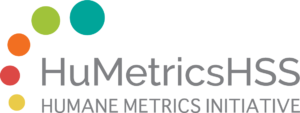Today is the first day of the Triangle Scholarly Communication Institute, where I am part of a team that’s focusing on HuMetrics: Building Humane Metrics for the Humanities. We have each agreed to quickly blog some thoughts as part of our process; warning: what follows is quickly-crafted prose, full of rough edges.
Is the project widely applicable? Can it scale? Is it extensible? These are questions I often asked potential applicants in my role of a granting officer at a federal humanities funding agency and, while reasonable to expect an articulated vision of impact when considered against a backdrop of limited funding and taxpayer support, we discussed today a troubling trend of emphasizing impact on the public good and growing expectations of broad public appeal as justification (or requirement) for continued support.
To be sure, scholars in the humanities and social sciences (HSS) must continue to improve the ways that we describe the work we do and the relevance of that work to the broader public. However, one of the questions for our #HuMetrics team at TriangleSCI is: Is there a way to measure engagement in small — let’s call them “local” contexts — that reflects the value of scholarship for small/local communities, that reflects impact along smaller scales appropriate to contextual expectations, and that challenges the very scale of the “public good” in which a public can be ten people rather than ten thousand or ten million?
As we asked in our framing document, “What of the obscure scholarship that uncovers major new territory within its field when that field is extremely small? How can we ensure that it is not only the importance of the loudly public that is measured?” When we focus on measures that are scaled to one trajectory, which is to say, more is better (more citations, a higher impact factor, more page views, more shares), we run into a common problem of failing to value context and simultaneously empowering a potentially dangerous narrative that ties significance to the speed and scale of popular understanding and engagement. How instead do we track (and value equally) engagement within a limited network?
Why is this important? The economy of scholarship cannot be unbound by the very funding structures that support them, perhaps best represented in the political battle over National Science Foundation (NSF) reauthorization where attempts were made to both significantly cut funding for social science research and, perhaps more important to our purposes here, tie grant review to an articulation of demonstrated value to “U.S. national security or economic interests,” a challenge to the value of basic research articulated by Vannevar Bush decades ago. Of course, humanities scholars have struggled with these questions of value and impact for decades, as Kathleen Fitzpatrick articulates in her recent posting on her new project on Generous Thinking: The University and the Public Good, but this expansion of using impact and the “public good” to limit research should give us pause as we think through metrics and impact, especially at scale.
Follow team #HuMetrics as we wrestle with humanities metrics. We are Christopher Long, Rebecca Kennison, Stacy Konkiel, Simone Sacchi, Jason Rhody, and Nicky Agate, and we’ll be writing here all week.
